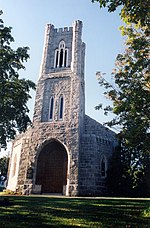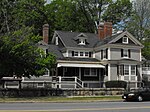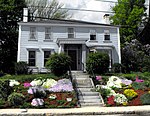Searles High School

Searles High School, now Methuen City Hall, is a historic former school building at 41 Pleasant Street in Methuen, Massachusetts, and an excellent example of English Renaissance Revival architecture. It was designed by Henry Vaughan, a favorite of wealthy industrialist Edward Searles, who funded construction of the building in 1904. Searles was a major presence in the town, also funding construction of the Vaughan-designed Methuen Memorial Music Hall. In the atrium rests an early small demonstration version of the Emancipation Memorial, which Searles purchased from its designer, Thomas Ball. The building was added to the National Register of Historic Places in 1984. It now houses offices of the City of Methuen.
Excerpt from the Wikipedia article Searles High School (License: CC BY-SA 3.0, Authors, Images).Searles High School
Pleasant Street, Methuen
Geographical coordinates (GPS) Address Nearby Places Show on map
Geographical coordinates (GPS)
| Latitude | Longitude |
|---|---|
| N 42.73 ° | E -71.183888888889 ° |
Address
Pleasant Street 40
01844 Methuen
Massachusetts, United States
Open on Google Maps











